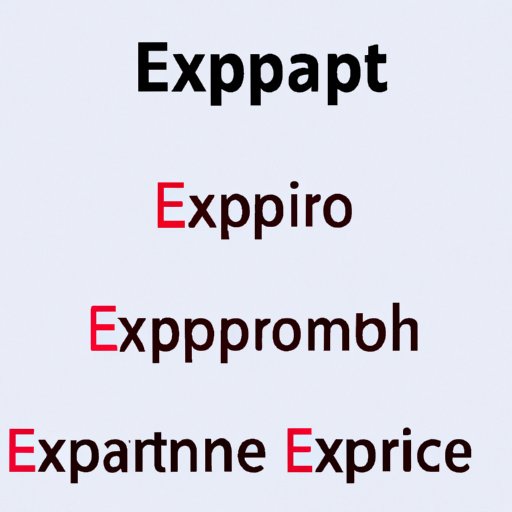Introduction
Expository writing is a form of writing that aims to explain a concept or idea in a clear and concise manner. This type of writing often uses facts and evidence to support the ideas presented and can be seen in many different contexts, from academic papers to business reports. In this article, we will explore what makes an example of expository writing, common examples of expository writing, and how expository writing is used in various fields.

Comparison of Expository Writing vs. Other Forms of Writing
Expository writing is one type of writing among many. Other types of writing include narrative, descriptive, argumentative, and persuasive writing. Each type of writing serves a different purpose and has its own set of rules and guidelines. Expository writing differs from these other types of writing because it focuses on providing information and explaining ideas rather than persuading or entertaining the reader. It is not meant to be opinionated or biased, but rather factual and objective.
What Makes an Example of Expository Writing?
Expository writing has certain characteristics that set it apart from other types of writing. These characteristics include:
- Use of facts and evidence to support ideas
- Objective and unbiased tone
- Clear and concise language
- Logical organization of ideas
In order to identify a piece of writing as expository, it is important to look at the purpose of the writing. Is the goal to explain a concept or provide information? If so, then the writing may be considered expository. Additionally, it is important to examine the content of the writing. Does the writing use facts and evidence to support the ideas presented? Does it maintain an objective and unbiased tone? Finally, it is important to consider the structure of the writing. Is the writing organized logically with a clear beginning, middle, and end? If all these criteria are met, then the writing can be considered an example of expository writing.
Common Examples of Expository Writing
Expository writing can be found in many different forms and contexts. Common examples of expository writing include:
- Academic writing – found in research papers, essays, and textbooks
- Business writing – found in memos, reports, and emails
- Technical writing – found in instructions, manuals, and guides
- Journalism – found in news articles, feature stories, and columns

Guide to Identifying Expository Writing in Different Contexts
In order to identify a piece of writing as expository, it is important to consider the purpose, content, and structure of the writing. Here are some tips for identifying expository writing in different contexts:
- Analyzing the Purpose of a Piece of Writing – Consider the goal of the writing. Is it to inform, explain, or describe? If so, then the writing may be expository.
- Examining the Content of a Piece of Writing – Look at the facts and evidence used to support the ideas presented. Does the writing remain objective and unbiased?
- Understanding the Structure of a Piece of Writing – Consider the organization of the writing. Is it logical and easy to follow? Does it have a clear beginning, middle, and end?

Look at How Expository Writing is Used in Various Fields
Expository writing is used in many different fields, such as education, science, and law. In education, expository writing is used to explain concepts and provide information about topics being studied. In science, expository writing is used to present data and findings from experiments and research. In law, expository writing is used to explain legal concepts and provide information about cases.
Conclusion
In conclusion, expository writing is a form of writing that aims to explain a concept or idea in a clear and concise way. It is characterized by the use of facts and evidence to support the ideas presented, an objective and unbiased tone, and a logical organization of ideas. Examples of expository writing can be found in many different contexts, including academic writing, business writing, technical writing, and journalism. To identify a piece of writing as expository, it is important to analyze the purpose, content, and structure of the writing. Expository writing is used in many different fields, such as education, science, and law.
When trying to identify expository writing, it is important to consider the purpose, content, and structure of the writing. It is also important to understand how expository writing is used in various fields. By following these steps, one should be able to accurately identify an example of expository writing.
(Note: Is this article not meeting your expectations? Do you have knowledge or insights to share? Unlock new opportunities and expand your reach by joining our authors team. Click Registration to join us and share your expertise with our readers.)
